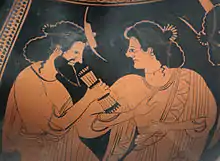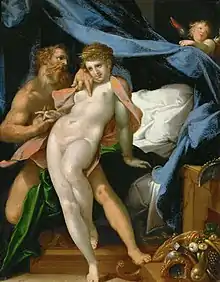Maia
Maia (/ˈmeɪ.ə/; Ancient Greek: Μαῖα; also spelled Maie, Μαίη; Latin: Maia),[1] in ancient Greek religion and mythology, is one of the Pleiades and the mother of Hermes, one of the major Greek gods, by Zeus, the king of Olympus.[2]
| Maia | |
|---|---|
| Member of the Pleiades | |
 | |
| Abode | Mount Cyllene, Arcadia |
| Personal information | |
| Parents | Atlas and Pleione or Aethra |
| Siblings |
(b) Hyades
|
| Consort | Zeus |
| Children | Hermes |
Family
Maia is the daughter of Atlas[3] and Pleione the Oceanid,[4] and is the oldest of the seven Pleiades.[5] They were born on Mount Cyllene in Arcadia,[4] and are sometimes called mountain nymphs, oreads; Simonides of Ceos sang of "mountain Maia" (Maiados oureias) "of the lovely black eyes."[5] Because they were daughters of Atlas, they were also called the Atlantides.[6]
| Part of a series on |
| Ancient Greek religion |
|---|
 |
Mythology

Birth of Hermes
According to the Homeric Hymn to Hermes, Zeus, in the dead of night, secretly made love to Maia,[8] who avoided the company of the gods, in a cave of Cyllene. She became pregnant with Hermes. After giving birth to the baby, Maia wrapped him in blankets and went to sleep. The rapidly maturing infant Hermes crawled away to Thessaly, where by nightfall of his first day he stole some of his half-brother Apollo's cattle and invented the lyre from a tortoise shell. Maia refused to believe Apollo when he claimed that Hermes was the thief, and Zeus then sided with Apollo. Finally, Apollo exchanged the cattle for the lyre, which became one of his identifying attributes.[9]
Although the Homeric Hymn has Maia as Hermes' caretaker and guardian, in Sophocles's now lost satyr play Ichneutae, Maia entrusted the infant Hermes to Cyllene (the local mountain goddess) to nurse and raise, and thus it is her that the satyrs and Apollo confront when looking for the god's missing cattle.[10]
As nurturer
Maia also raised the infant Arcas, the child of Callisto with Zeus. Wronged by the love affair, Zeus' wife Hera in a jealous rage had transformed Callisto into a bear.[11] Arcas is the eponym of Arcadia, where Maia was born.[4] The story of Callisto and Arcas, like that of the Pleiades, is an aition for a stellar formation, the constellations Ursa Major and Ursa Minor, the Great and Little Bear.
Her name is related to μαῖα (maia), an honorific term for older women related to μήτηρ (mētēr) 'mother', also meaning "midwife" in Greek.[12]
Roman Maia

In ancient Roman religion and myth, Maia embodied the concept of growth,[13] as her name was thought to be related to the comparative adjective maius, maior "larger, greater". Originally, she may have been a homonym independent of the Greek Maia, whose myths she absorbed through the Hellenization of Latin literature and culture.[14]
In an archaic Roman prayer,[15] Maia appears as an attribute of Vulcan, in an invocational list of male deities paired with female abstractions representing some aspect of their functionality. She was explicitly identified with Earth (Terra, the Roman counterpart of Gaia) and the Good Goddess (Bona Dea) in at least one tradition.[16][17] Her identity became theologically intertwined also with the goddesses Fauna, Ops, Juno, Carna, and the Magna Mater ("Great Goddess", referring to the Roman form of Cybele but also a cult title for Maia), as discussed at some length by the late antiquarian writer Macrobius.[18] This treatment was probably influenced by the 1st-century BC scholar Varro, who tended to resolve a great number of goddesses into one original "Terra".[17] The association with Juno, whose Etruscan counterpart was Uni, is suggested again by the inscription Uni Mae on the Piacenza Liver.[19]
The month of May (Latin Maius) was named for Maia,[20] though ancient etymologists also connected it to the maiores "ancestors", again from the adjective maius, maior, meaning those who are "greater" in terms of generational precedence.[21] On the first day of May, the Lares Praestites were honored as protectors of the city,[22] and the flamen of Vulcan sacrificed a pregnant sow to Maia, a customary offering to an earth goddess[23] that reiterates the link between Vulcan and Maia in the archaic prayer formula. In Roman myth, Mercury (Hermes), the son of Maia, was the father of the twin Lares, a genealogy that sheds light on the collocation of ceremonies on the Kalends of May.[24] On May 15, the Ides, Mercury was honored as a patron of merchants and increaser of profit (through an etymological connection with merx, merces, "goods, merchandise"), another possible connection with Maia his mother as a goddess who promoted growth.[13]
See also
- 66 Maja, asteroid
- Bona Dea
- Maia (star)
- Maiasaura
- Rosmerta
Notes
- The alternate spelling Maja represents the intervocalic i as j, pronounced similarly to an initial y in English; hence Latin maior, "greater," in English became "major."
- Homer, Odyssey 14.435; Apollodorus, 3.10.2; Horace, Odes 1.10.1 & 2.42 ff.; Tzetzes on Lycophron, 219
- The alternate spelling Maja represents the intervocalic i as j, pronounced similarly to an initial y in English; hence Latin maior, "greater," in English became "major."
- Hesiod, Theogony 938
- Apollodorus, 3.10.1
- Simonides, fr. 555
- Although the identification of Mercury is secure, based on the presence of the caduceus, the one-shouldered garment called the chlamys, and his winged head, the female figure has been identified variously. The cup is part of the Berthouville Treasure, found within a Gallo-Roman temple precinct; see Lise Vogel, The Column of Antoninus Pius, Loeb Classical Library Monograph (Harvard University Press, 1973), p. 79 f., and Martin Henig, Religion in Roman Britain, Taylor & Francis, 1984, 2005, p. 119 f. In Gaul, Mercury's regular consort is one of the Celtic goddesses, usually Rosmerta. The etymology of Rosmerta's name as "Great Provider" suggests a theology compatible with that of Maia "the Great". The consort on the cup has also been identified as Venus by M. Chabouillet, Catalogue général et raisonné des camées et pierres gravées de la Bibliothéque Impériale, Paris 1858, p. 449. Maia is suggested by the concomitant discovery of a silver bust, not always considered part of the hoard proper but more securely identified as Maia and connected to Rosmerta; see E. Babelon, Revue archéologique 24 (1914), pp. 182–190, as summarized in American Journal of Archaeology 19 (1915), p. 485.
- Homeric Hymns 4.5
- Apollodorus, 3.10.2
- Ormand, Kirk (2012). A Companion to Sophocles. Wiley Blackwell. p. 163. ISBN 978-1-119-02553-5.
- Apollodorus, 3.8.2
- Nutton, Vivian (2005). Ancient Medicine. London: Routledge. p. 101. ISBN 9780415086110.
- Turcan, Robert (2001). The Gods of Ancient Rome - Religion in Everyday Life from Archaic to Imperial Times. London: Routledge. p. 70. ISBN 9780415929745.
- Grimal, Pierre (1996). The Dictionary of Classical Mythology. Blackwell. p. 270.
- Aulus Gellius, Attic Nights 13.10.2
- By Cornelius Labeo, as recorded by Macrobius, Saturnalia 1.12.20
- Brouwer, H.H.J. (1989). Bona Dea: The Sources and a Description of the Cult. Brill. pp. 232, 354. ISBN 9789004295773.
- Macrobius, Saturnalia 1.12.16–33
- In Mario Torelli's diagram of this haruspicial object, the names Uni and Mae appear together in a cell on the edge of the liver; see Nancy Thompson de Grummond, Etruscan Myth, Sacred History, and Legend, University of Pennsylvania Museum of Archaeology, 2006, p. 44 (online).
- British Museum (29 December 2017). "What's in a name? Months of the year". Retrieved 8 May 2022.
- Ovid Fasti 5.73
- Ovid, Fasti 5.73; Turcan, The Gods of Ancient Rome, p. 70.
- Macrobius, Saturnalia 1.12.20; Juvenal, Satires 2.86; Festus, 68
- Wiseman, Timothy Peter (1995). Remus: A Roman Myth. Cambridge University Press. p. 71. ISBN 9780521483667.
References
- Apollodorus, The Library with an English Translation by Sir James George Frazer, F.B.A., F.R.S. in 2 Volumes, Cambridge, MA, Harvard University Press; London, William Heinemann Ltd. 1921. ISBN 0-674-99135-4. Online version at the Perseus Digital Library. Greek text available from the same website.
- Diodorus Siculus, The Library of History translated by Charles Henry Oldfather. Twelve volumes. Loeb Classical Library. Cambridge, Massachusetts: Harvard University Press; London: William Heinemann, Ltd. 1989. Vol. 3. Books 4.59–8. Online version at Bill Thayer's Web Site
- Diodorus Siculus, Bibliotheca Historica. Vol 1-2. Immanel Bekker. Ludwig Dindorf. Friedrich Vogel. in aedibus B. G. Teubneri. Leipzig. 1888-1890. Greek text available at the Perseus Digital Library.
- Hesiod, Theogony from The Homeric Hymns and Homerica with an English Translation by Hugh G. Evelyn-White, Cambridge, MA.,Harvard University Press; London, William Heinemann Ltd. 1914. Online version at the Perseus Digital Library. Greek text available from the same website.
- Publius Ovidius Naso, Fasti translated by James G. Frazer. Online version at the Topos Text Project.
- Publius Ovidius Naso, Fasti. Sir James George Frazer. London; Cambridge, MA. William Heinemann Ltd.; Harvard University Press. 1933. Latin text available at the Perseus Digital Library.
- The Homeric Hymns and Homerica with an English Translation by Hugh G. Evelyn-White. Homeric Hymns. Cambridge, MA.,Harvard University Press; London, William Heinemann Ltd. 1914. Online version at the Perseus Digital Library. Greek text available from the same website.
Further reading
- Grimal, Pierre, The Dictionary of Classical Mythology, Wiley-Blackwell, 1996, ISBN 978-0-631-20102-1. "Maia" p. 270
- Harry Thurston Peck, Harper's Dictionary of Classical Antiquities, 1898
- Smith, William; Dictionary of Greek and Roman Biography and Mythology, London (1873). "Maia"
- Encyclopædia Britannica, 1911.